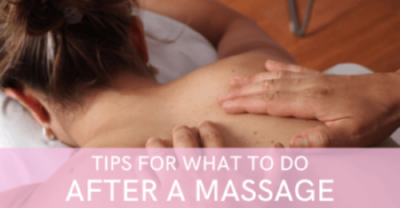
You most likely schedule a massage to eliminate pain, reduce stress, and get relief from tight muscles. However, as part of the healing process, you may feel some pain, bruising, muscle soreness, or tightness afterward. Before wondering what the therapist did to put you in a state of agony, realize that just like the soreness you may feel after a workout, massage can stimulate areas of your body that you haven’t targeted recently. If you’re feeling pain in certain parts of your body, you may unconsciously ignore this spot, which can cause tension. A massage can highlight areas of your body where you’re holding on to stress.
Some pain and discomfort after a massage is normal. This reaction by your body to the massage is sometimes called “therapeutic inflammation”. Therapeutic inflammation occurs when new white blood cells move toward the massaged area to clean out waste products that have developed over time from injury, stiffness, and more. This can sometimes cause discomfort in the area which at many times may make you feel like the massage therapist did something wrong. Not to worry though, this is just a natural reaction by your body’s innate healing process.
What about the bruising? There are many reasons a person may experience bruising after a massage. Certain types of massage, such as deep tissue and shiatsu, are more likely to cause pain and leave you feeling very sore after your massage. If you’re super sensitive, have a lot of pain or tension, or simply want to avoid feeling sore afterward, opt for a massage that uses a light, gentle pressure such as a Swedish massage. There are many other factors that can cause bruising such as sensitive skin, vitamin C deficiency, age and more. Other things that may make you more susceptible to pain and bruising after your massage are smoking, drinking, lack of sleep, hidden injuries, and much more. Lifestyle and good health play a vital role in recovery.
So the next time you wake up the next day after the massage and you feel like you got run over by a semi-truck, don’t automatically blame your massage therapist. Remember, if your therapist has massaged thousands of other people and they don’t get the same complaint, look at other factors as well. It may just be your body healing and that is a good thing. If, however, that pain doesn’t subside or gets worse, make sure that you seek medical attention.
What actually causes the soreness and bruising?
Massage carries blood and nutrients to your muscles while eliminating toxins. After stimulating muscles that you may not usually use, you might experience delayed onset muscle soreness. This is a physical response to the inflammation as your body heals.
This can happen if your muscles aren’t accustomed to massage or if you have lactic acidosis, which is a buildup of lactic acid in your body. In the same way that your body gets used to working out, your muscles need time to get used to being manipulated in certain ways.
You may experience inflammation and soreness in areas that need healing. If you have neck pain after a massage, for example, it can be a sign that you carry a lot of tension in that area. You may have limited flexibility and mobility in your neck due to working at a desk or bending forward repeatedly.
Here are 9 ways to relieve muscle soreness after your massage
Most soreness after a massage will subside within a day or so. In the meantime, there are several ways to relieve soreness.
1. Keep your body hydrated
Drink lots of water before and after your massage. This helps flush out toxins or acids that rise to the surface during your massage.
Avoid alcoholic, sugs, and caffeinated drinks. Along with water, opt for healthy options such as coconut water, fresh fruit or vegetable juice, or herbal teas.
2. Stretch out your muscles
After getting your massage, do a few gentle stretches on your own. This helps reduce muscle tension, increase flexibility, and improve circulation.
3. Heat up your body
Warm your body up to promote relaxation in your muscles and increase circulation. Take a hot shower or go to the sauna. Add baking soda or Epsom salt to a bath and soak for up to 30 minutes. You can also use a heating pad or hot rice bag on any painful areas for up to 15 minutes at a time.
4. Use essential oils
Essential oils are great for pain relief. Add a few drops to your bath or shower or use a diffuser.
5. Topical treatment
Applying a muscle rub or CBD lotion is also a great way to administer self-massage. Spend several minutes applying the ointment while giving yourself a mini-massage in the process.
6. Herbal relief is a great option
There are several herbs that may help stimulate muscle relaxation and decrease inflammation. Herbs come in the form of a capsule, tincture, or tea.
Several herbal options are turmeric, clove, black pepper, ginger, cinnamon, garlic and cayenne.
7. Rest your body
Take some time to rest and recharge after your massage.
8. Guided meditation
Lie on a mat or bed and listen to some mindful tunes. Calm your mind and soul and your body will thank you.
9. Cold therapy
A great way to reduce inflammation is to use an ice pack on any painful areas for 15 minutes at a time a few times a day. Or, take an ice bath to relieve inflammation, alleviate soreness, and boost blood flow.